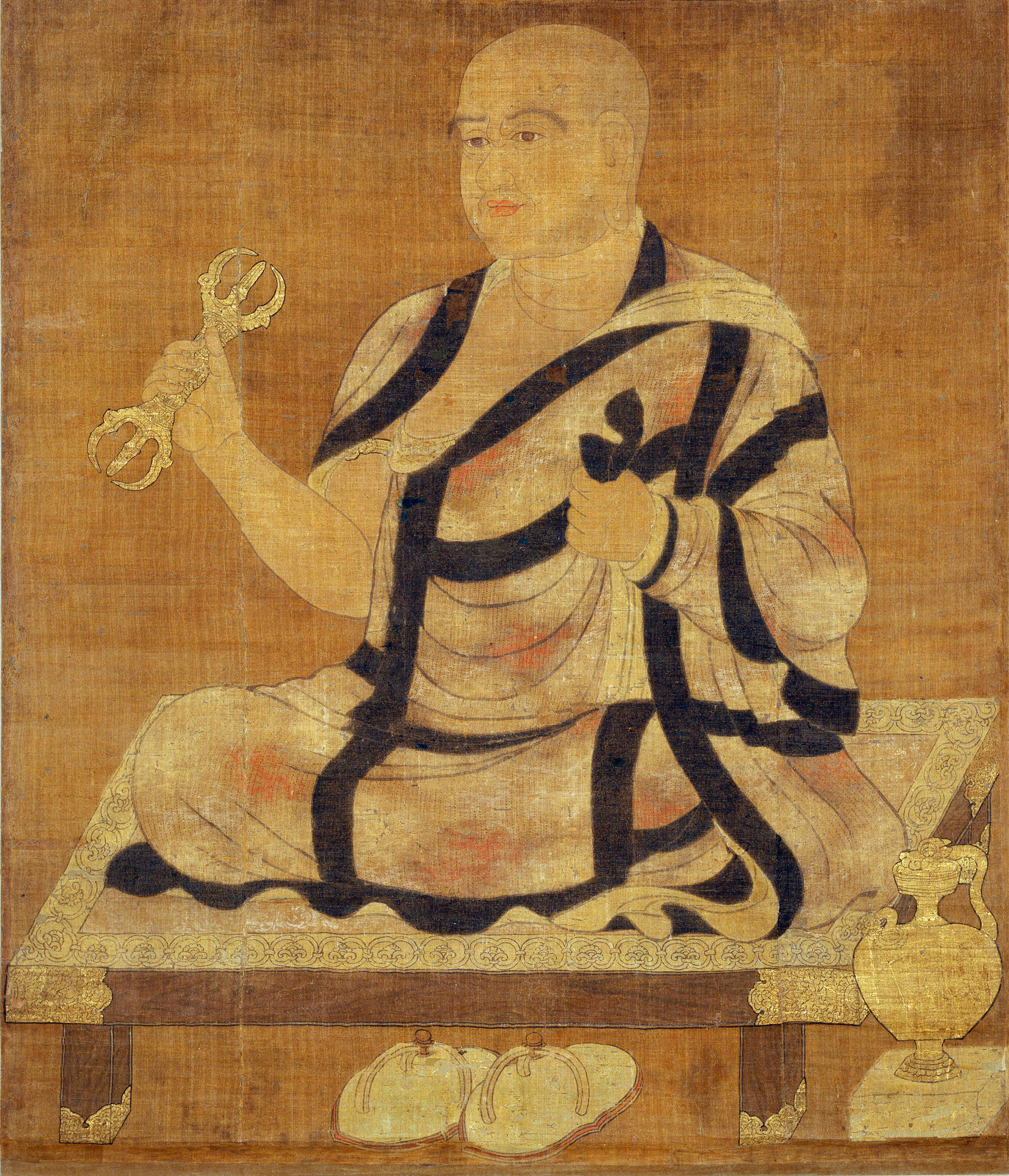|
Pratibandhaka
Pratibandhaka (Sanskrit: प्रतिबन्धक) variously means – 'opposition', 'resistance', 'investment', 'blockade', 'siege', 'invariable and inseparable connection', 'cessation', 'disappointment'; it also means – 'impediment', 'obstacle', 'cognitive blocker', 'antidote' or 'preventive measure'. ''Pratibandhaka'' is a causal dependency and refers to something that must perform the specific function of obstructing. Jaina concept of causal power Prabhachandra, the disciple of Akalarika, endorses the Jaina argument that the causal complex has the causal power of producing effect owing to the existence of some extra-sensory power ('' shakti ''), that the hindrance in the origination of an effect is caused by counter-agents (''pratibandhaka'') is due to the special power. The followers of Jainism believe that the universe is full of karmic molecules whose mundane inflow towards the soul is caused by its own vibratory activities through mind, speech and body. Karma is ... [...More Info...] [...Related Items...] OR: [Wikipedia] [Google] [Baidu] |
Sanskrit
Sanskrit (; attributively , ; nominalization, nominally , , ) is a classical language belonging to the Indo-Aryan languages, Indo-Aryan branch of the Indo-European languages. It arose in South Asia after its predecessor languages had Trans-cultural diffusion, diffused there from the northwest in the late Bronze Age#South Asia, Bronze Age. Sanskrit is the sacred language of Hinduism, the language of classical Hindu philosophy, and of historical texts of Buddhism and Jainism. It was a lingua franca, link language in ancient and medieval South Asia, and upon transmission of Hindu and Buddhist culture to Southeast Asia, East Asia and Central Asia in the early medieval era, it became a language of religion and high culture, and of the political elites in some of these regions. As a result, Sanskrit had a lasting impact on the languages of South Asia, Southeast Asia and East Asia, especially in their formal and learned vocabularies. Sanskrit generally connotes several Indo-Aryan lang ... [...More Info...] [...Related Items...] OR: [Wikipedia] [Google] [Baidu] |
Vedas
upright=1.2, The Vedas are ancient Sanskrit texts of Hinduism. Above: A page from the '' Atharvaveda''. The Vedas (, , ) are a large body of religious texts originating in ancient India. Composed in Vedic Sanskrit, the texts constitute the oldest layer of Sanskrit literature and the oldest scriptures of Hinduism. There are four Vedas: the Rigveda, the Yajurveda, the Samaveda and the Atharvaveda. Each Veda has four subdivisions – the Samhitas ( mantras and benedictions), the Aranyakas (text on rituals, ceremonies, sacrifices and symbolic-sacrifices), the Brahmanas (commentaries on rituals, ceremonies and sacrifices), and the Upanishads (texts discussing meditation, philosophy and spiritual knowledge).Gavin Flood (1996), ''An Introduction to Hinduism'', Cambridge University Press, , pp. 35–39A Bhattacharya (2006), ''Hindu Dharma: Introduction to Scriptures and Theology'', , pp. 8–14; George M. Williams (2003), Handbook of Hindu Mythology, Oxford University Pres ... [...More Info...] [...Related Items...] OR: [Wikipedia] [Google] [Baidu] |
History Of Logic
The history of logic deals with the study of the development of the science of valid inference (logic). Formal logics developed in ancient times in India, China, and Greece. Greek methods, particularly Aristotelian logic (or term logic) as found in the ''Organon'', found wide application and acceptance in Western science and mathematics for millennia.Boehner p. xiv The Stoics, especially Chrysippus, began the development of predicate logic. Christian and Islamic philosophers such as Boethius (died 524), Ibn Sina (Avicenna, died 1037) and William of Ockham (died 1347) further developed Plato's logic in the Middle Ages, reaching a high point in the mid-fourteenth century, with Jean Buridan. The period between the fourteenth century and the beginning of the nineteenth century saw largely decline and neglect, and at least one historian of logic regards this time as barren.Oxford Companion p. 498; Bochenski, Part I Introduction, ''passim'' Empirical methods ruled the day, as evidenced ... [...More Info...] [...Related Items...] OR: [Wikipedia] [Google] [Baidu] |
Hindu Philosophical Concepts
Hindus (; ) are people who religiously adhere to Hinduism. Jeffery D. Long (2007), A Vision for Hinduism, IB Tauris, , pages 35–37 Historically, the term has also been used as a geographical, cultural, and later religious identifier for people living in the Indian subcontinent. The term ''"Hindu"'' traces back to Old Persian which derived these names from the Sanskrit name ''Sindhu'' (सिन्धु ), referring to the river Indus. The Greek cognates of the same terms are "''Indus''" (for the river) and "''India''" (for the land of the river). The term "''Hindu''" also implied a geographic, ethnic or cultural identifier for people living in the Indian subcontinent around or beyond the Sindhu (Indus) River. By the 16th century CE, the term began to refer to residents of the subcontinent who were not Turkic or Muslims. Hindoo is an archaic spelling variant, whose use today is considered derogatory. The historical development of Hindu self-identity within the local In ... [...More Info...] [...Related Items...] OR: [Wikipedia] [Google] [Baidu] |
Rasayana
''Rasāyana'' (रसायन) is a Sanskrit word literally meaning ''path'' (''ayana'') ''of essence'' (''rasa''). It is an early ayurvedic medical term referring to techniques for lengthening lifespans and invigorating the body. It is one of the eight areas of medicine in Sanskrit literature. In Vedic alchemical context, "rasa" also translates to "metal or a mineral" History The more general name for the Indian science of alchemy or proto-chemistry is ''Rasaśāstra (रसशास्त्र in Sanskrit)'', or "The Science of Mercury," in Nepali, Marathi, Hindi, Kannada and several other languages. Early Indian alchemical texts discuss the use of prepared forms of mercury or cinnabar (see samskaras). However, there is also ample mention of the preparation of medical tinctures in the early science of Indian alchemy. Significant progress in alchemy was made in ancient India. An 11th-century Persian chemist and physician named Abū Rayhān Bīrūnī reported " he India ... [...More Info...] [...Related Items...] OR: [Wikipedia] [Google] [Baidu] |
Herbal
A herbal is a book containing the names and descriptions of plants, usually with information on their medicinal, tonic, culinary, toxic, hallucinatory, aromatic, or magical powers, and the legends associated with them.Arber, p. 14. A herbal may also classify the plants it describes, may give recipes for herbal extracts, tinctures, or potions, and sometimes include mineral and animal medicaments in addition to those obtained from plants. Herbals were often illustrated to assist plant identification.Anderson, p. 2. Herbals were among the first literature produced in Ancient Egypt, China, India, and Europe as the medical wisdom of the day accumulated by herbalists, apothecaries and physicians. Herbals were also among the first books to be printed in both China and Europe. In Western Europe herbals flourished for two centuries following the introduction of moveable type (c. 1470–1670). In the late 17th century, the rise of modern chemistry, toxicology and pharmacol ... [...More Info...] [...Related Items...] OR: [Wikipedia] [Google] [Baidu] |
Triphala
Triphala ("three fruits") is an Ayurvedic herbal rasayana formula consisting of equal parts of three myrobalans, taken without seed: Amalaki (''Phyllanthus emblica''), Bibhitaki ('' Terminalia bellirica''), and Haritaki ('' Terminalia chebula''). It contains vitamin C. See also *Ayurveda Ayurveda () is an alternative medicine system with historical roots in the Indian subcontinent. The theory and practice of Ayurveda is pseudoscientific. Ayurveda is heavily practiced in India and Nepal, where around 80% of the population repor ... * Rasayana References {{Reflist Ayurvedic medicaments ... [...More Info...] [...Related Items...] OR: [Wikipedia] [Google] [Baidu] |
Ayurveda
Ayurveda () is an alternative medicine system with historical roots in the Indian subcontinent. The theory and practice of Ayurveda is pseudoscientific. Ayurveda is heavily practiced in India and Nepal, where around 80% of the population report using it. Ayurveda therapies have varied and evolved over more than two millennia. Therapies include herbal medicines, special diets, meditation, yoga, massage, laxatives, enemas, and medical oils. Ayurvedic preparations are typically based on complex herbal compounds, minerals, and metal substances (perhaps under the influence of early Indian alchemy or '' rasashastra''). Ancient Ayurveda texts also taught surgical techniques, including rhinoplasty, kidney stone extractions, sutures, and the extraction of foreign objects. The main classical Ayurveda texts begin with accounts of the transmission of medical knowledge from the gods to sages, and then to human physicians. Printed editions of the '' Sushruta Samhita'' (''Sushruta's C ... [...More Info...] [...Related Items...] OR: [Wikipedia] [Google] [Baidu] |
Brahmaloka
Brahmaloka (Sanskrit: ब्रह्मालोक, IAST: Brahmāloka) or Satyaloka (Sanskrit: सत्यलोक) is the abode of Brahma, the creator god, a member of the Trimurti along with Vishnu and Shiva, along with his consort Saraswati. It is also referred to as Brahmapura, in the Puranas. Brahmaloka, described to be 60,000,000 miles above the Prajapati loka, is considered to be of great soteriological significance, the sphere where its inhabitants never again know death, dwelling perpetually in the company of yogins, and drinking the excellent nectar of yoga. Location In the center of Brahmaloka is Brahmapura, a huge palace where Brahma resides. Description Brahmaloka is a realm composed entirely of Brahman, considered superior to the Svarga loka and is full of immortal energy, knowledge and bliss. It is also known as the planet of the Bhagavān. The above statement shows that Brahmaloka is an eternal Vaikuntha that is neither created nor located within th ... [...More Info...] [...Related Items...] OR: [Wikipedia] [Google] [Baidu] |
Yogi
A yogi is a practitioner of Yoga, including a sannyasin or practitioner of meditation in Indian religions.A. K. Banerjea (2014), ''Philosophy of Gorakhnath with Goraksha-Vacana-Sangraha'', Motilal Banarsidass, , pp. xxiii, 297-299, 331 The feminine form, sometimes used in English, is yogini. Yogi has since the 12th century CE also denoted members of the Nath siddha tradition of Hinduism, and in Hinduism, Buddhism and Jainism, a practitioner of tantra.Rita Gross (1993), ''Buddhism After Patriarchy'', SUNY Press, , pages 85–88 In Hindu mythology, the god Shiva and the goddess Parvati are depicted as an emblematic yogi–yogini pair. Etymology In Classical Sanskrit, the word ''yogi'' (Sanskrit: masc ', योगी; fem ') is derived from ''yogin'', which refers to a practitioner of yoga. ''Yogi'' is technically male, and ''yoginī'' is the term used for female practitioners. The two terms are still used with those meanings today, but the word ''yogi'' is also us ... [...More Info...] [...Related Items...] OR: [Wikipedia] [Google] [Baidu] |
Brahman
In Hinduism, ''Brahman'' ( sa, ब्रह्मन्) connotes the highest universal principle, the ultimate reality in the universe.P. T. Raju (2006), ''Idealistic Thought of India'', Routledge, , page 426 and Conclusion chapter part XII In major schools of Hindu philosophy, it is the material, efficient, formal and final cause of all that exists.For dualism school of Hinduism, see: Francis X. Clooney (2010), ''Hindu God, Christian God: How Reason Helps Break Down the Boundaries between Religions'', Oxford University Press, , pages 51–58, 111–115;For monist school of Hinduism, see: B. Martinez-Bedard (2006), ''Types of Causes in Aristotle and Sankara'', Thesis – Department of Religious Studies (Advisors: Kathryn McClymond and Sandra Dwyer), Georgia State University, pages 18–35 It is the pervasive, infinite, eternal truth, consciousness and bliss which does not change, yet is the cause of all changes. ''Brahman'' as a metaphysical concept refers to the singl ... [...More Info...] [...Related Items...] OR: [Wikipedia] [Google] [Baidu] |



.jpg)




